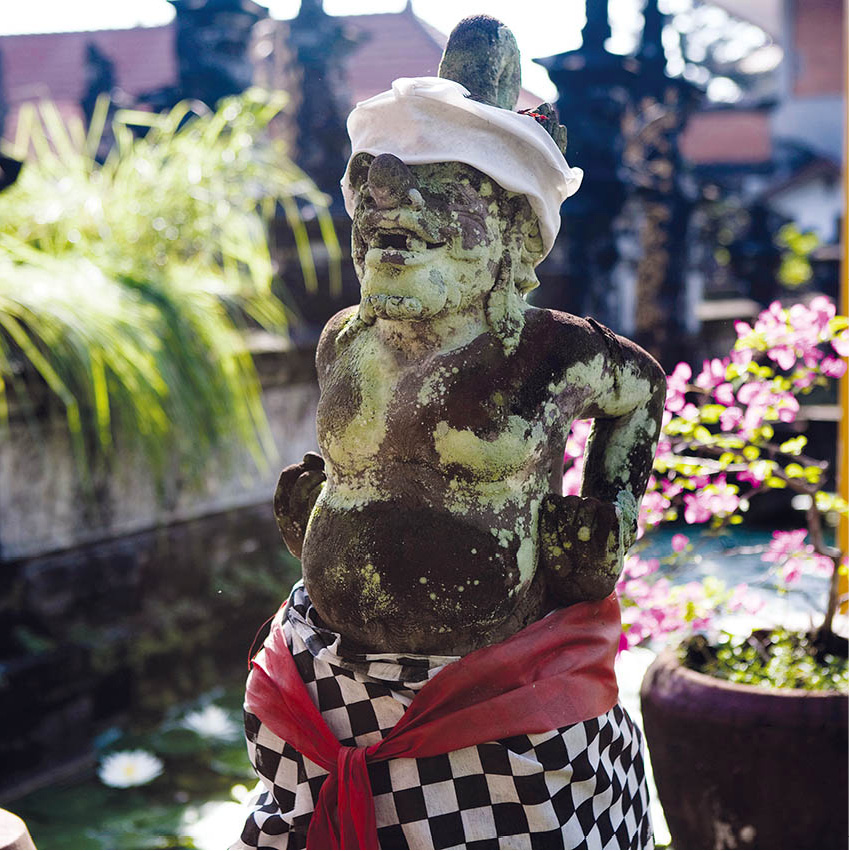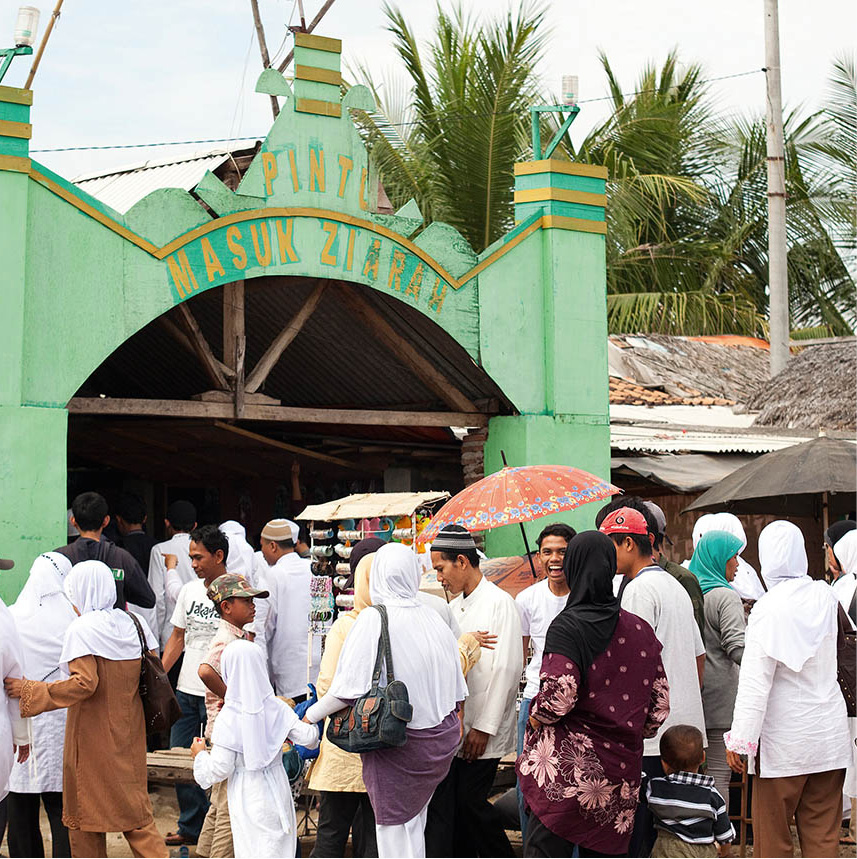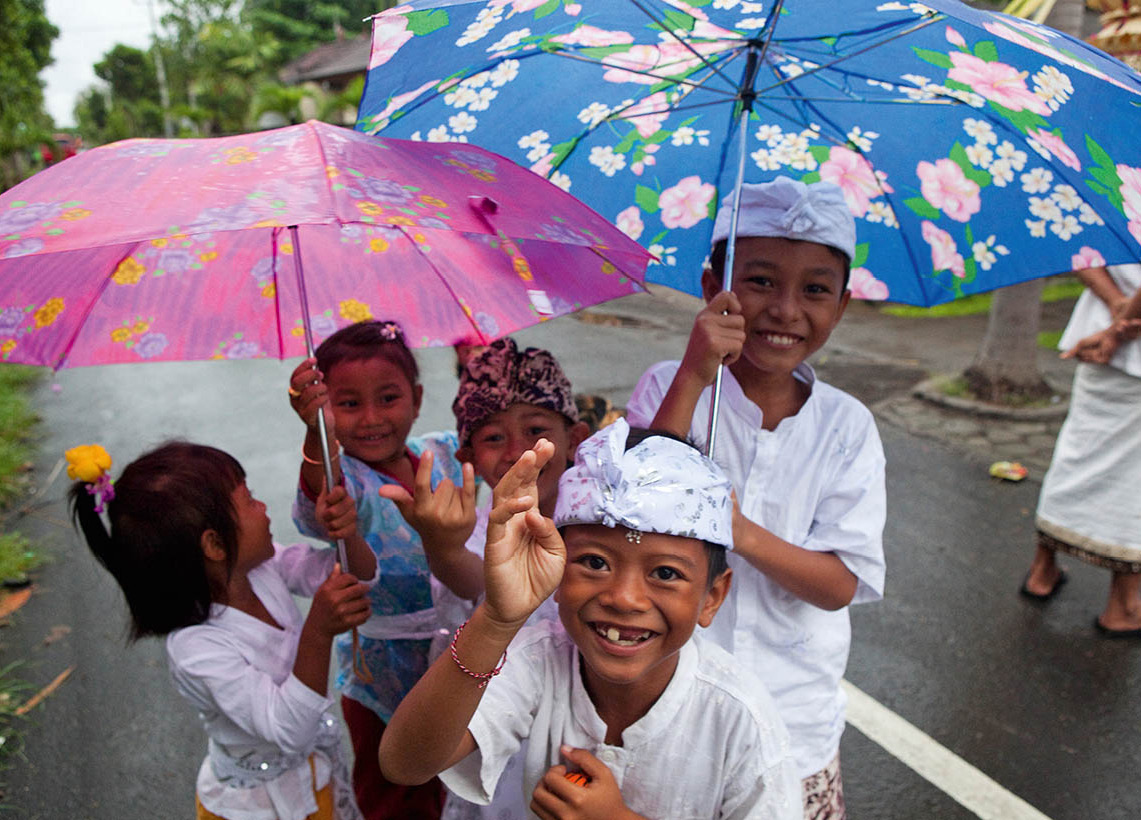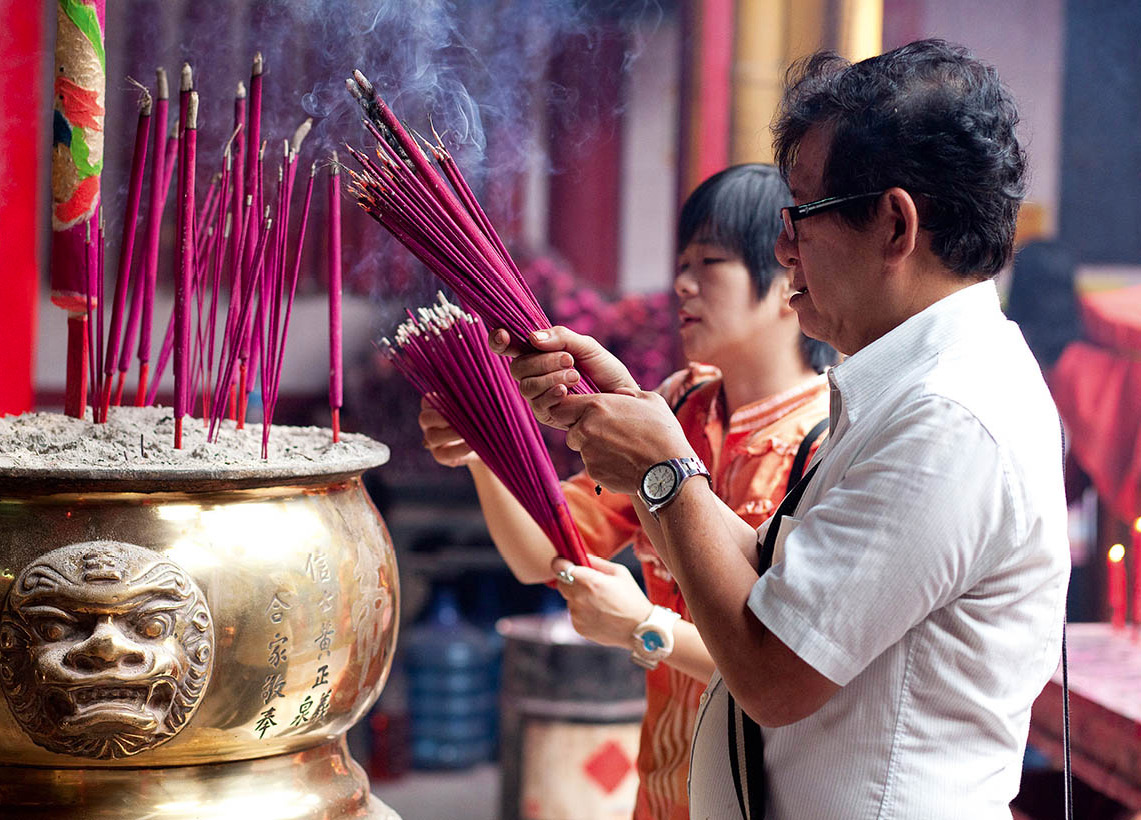Although Indonesia has the world’s largest Muslim population, it is not an Islamic state. Nearly 90 percent of its citizens are Muslim, with most of the remainder being Christian, Hindu, Buddhist and Confucian. Pockets of Christianity are found among the Batak people of North Sumatra, the Ambonese, Florinese and in Papua, and in a few areas of Kalimantan. Indonesian Christians are few in number but well represented within the educated military and political elite. Similarly, there is a small minority of Buddhist and Confucian Indonesians, mainly Chinese. As with Buddhism, Hinduism was at one time a significant power in the archipelago, but its presence is now limited to Bali, East Java and western Lombok.
Generally speaking, most Indonesians are staunch believers in their chosen faiths, but none of the religions is practised in the forms they are in other countries. Often enmeshed with animism, Hindu-Buddhist or customary practices, they are – as with many things – uniquely Indonesian. With so many ethnic and cultural groups, traditions, languages and religions spread over vast distances, throughout Indonesia’s history there has been a convergence of basic social, cultural and political needs. In many ways, the traditional tolerance that Islam teaches has permitted a give-and-take to this end. Although there are pockets of extremists, they are by far in the minority.

Balinese temple courtyard.
Corrie Wingate/Apa Publications
One God
The Indonesian constitution guarantees freedom to worship as one pleases. Yet, only certain religions have been officially recognised (with Confucianism only added to the list in 2000). Pancasila, the state ideology created by Sukarno in 1945, demanded religions must recognise one god: Balinese Hinduism and others ‘appointed’ a supreme being in order to qualify.
It is commonly believed that the one-god proviso was part of Sukarno’s efforts to ensure that Indonesian identity was not defined as Islamic. Another theory is that by precluding primitive animistic worship, he could ‘civilise’ Indonesia’s varied peoples, or at least appear to the outside world to have done so.
Animism
The native religion, animism – essentially the worship of spirits believed to preside in all living or non-living things – is still practised on remote islands and is mixed freely with modern religions. Animism rests on the basis that both animate and inanimate objects are inhabited by living spirits.
Offerings of food are sometimes found beside a tree or a river, placed in appeasement of the nearby deity in the hope of being granted a safe passage, a rich harvest or a good day’s fishing. There is usually a spirit medium or dukun in each village who enjoys high status, since he plays the all-important role of intermediary to the spirits.
Despite national statistics that claim high adherence to foreign religions, the spirit of animism continues to rule social behaviour. In everyday practical life, worship of mainstream faiths does not rule out ingrained fundamental beliefs in the power of spirits nor preclude the enactment of rituals of appeasement.

Almost 90 percent of Indonesians follow Islam.
Corrie Wingate/Apa Publications
Islam
The most significant of the major religions in Indonesia is Islam, which became the fulcrum for the region’s development. By the late 13th century, Islam had gained a foothold in Sumatra and, within a few centuries, had become embedded in Southeast Asia, anchored by a powerful Islamic commercial and political centre in Malacca during the 15th century.
Although Indonesia has an overwhelming majority of Muslims, religious tolerance and freedom of religion is guaranteed by the constitution. Political parties based on moderate Islamic beliefs have had significant representation in parliament, but they do not dominate, whereas fundamentalist Islamist parties have had little impact in elections.
The faith is practised most traditionally in Aceh, North Sumatra – the only province that adheres to Sharia (Islamic) law. West Java, Madura (East Java), Southeast Kalimantan and western Lombok are other devoutly Muslim regions. Elsewhere, Islam may be the professed religion, but the strict rituals, of fasting and prayers for example, are less rigidly followed than in other Muslim-majority countries. On Java, perhaps one-third to a half of Muslims adhere to strict practices.
Islam’s rituals are intertwined with the basic needs and acts of daily life and define the nature and quality of life itself and of the community. Islamic beliefs and practices are based upon two important touchstones: the Koran (Qur’an) and the Sunnah. The Koran is considered to be the word of God, as spoken to Muhammad (c. AD 570–632) during the last 22 years of his life, through the angel Gabriel. And as it is considered the word of God, the Koran in all its 114 chapters is irrefutable and faultless.
The Sunnah, less well known to outsiders, reflects the traditional norms regarding assorted concerns and issues, based upon what Muhammad himself did or said regarding those concerns. Although secondary to the Koran, it is a fundamental component for most Muslims.

Christian wedding ceremony, Samosir Island, Sumatra.
Corrie Wingate/Apa Publications
Cousin to Christianity
Little known among non-Muslims is that Islam accepts most biblical miracles and prophets, in both the Old and New Testaments. Abraham, Moses and Jesus, for example, are important prophets. Adam was the first prophet, later forgiven by God for his sins. But they were early prophets. Muhammad came later as the last and final prophet, and thus revealed a more perfect word of God. The Koran itself is considered Muhammad’s eclipsing miracle, as perfect as possible on earth. Islam regards all religions as essentially representations of the same divine truth, except that Islam is closest to that truth.
The Islamic Allah is omnipotent and singular, but there are permutations of this fundamental idea throughout Indonesia, where local and often polytheistic beliefs, and in some places, from Hinduism and Buddhism, have been melded with Islam. This modifying of practice and doctrine is not restricted to Islam and is found in all religions.
In common with Christianity, there is a heaven and a hell in Islam. The world’s creation was an act of mercy by God; if God had not done so, there would be nothingness. Everything on earth has its function and form, defined towards making a harmonious world. Nature exists to be exploited by humanity, and the purpose of humans is simple: to serve God. But, unlike Christianity, which is more individualistic, Islam has it that humanity’s responsibility includes the establishment of social systems that are pure and free from vice and corruption. Allah also judges societies and nations, which are subject to the same transgressions and weaknesses as people.
The basis of an Islamic society is the sustenance of the community of the faithful, guided by Sharia, or Islamic law. This law defines a community’s moral goals; in fact, in other majority-Muslim countries, Islam defines all the laws, both moral and legal.
According to the Koran, people are proud, if not egotistical, and susceptible to selfishness and greed. (Satan is a significant factor in earthly affairs.) Belief in the Koran is said to assist people in rising above these inadequacies by establishing an inner ethical bearing called taqwa. Through this quality, good and evil, and right and wrong, are recognisable. In the end, a person is judged by taqwa, not by earthly deeds or accomplishments. The role of the Islamic prophets has been to show individuals, as well as whole societies and even nations, the way to taqwa.

Villagers celebrating an odalan festival, Bali.
Corrie Wingate/Apa Publications
Balinese Hinduism
Most of Indonesia’s Hindus live on Bali, where they form more than 90 percent of the Balinese population. Balinese Hinduism has developed local characteristics that distinguish it from Indian Hinduism.
Central to Balinese Hinduism – known as Agama Hindu Dharma – is the belief in the balance of two opposite forces, manifested as good and evil; light and dark; male and female; positive and negative; order and chaos, and so on. The two realms coexist and are equally important.
Good, as represented by benevolent gods such as Dewa and Bhatara, is to be emulated, cultivated and esteemed. Worship of these gods is marked by offerings of food, holy water and flowers, dancing and beautiful art pieces. Credit for a bountiful harvest, for example, is given to the popular goddess of rice and fertility, Dewi Sri.
The hierarchy of Balinese gods begins with Sanghyang Widi Wasa, the supreme invisible being who is manifested through the three gods: Brahma, Vishnu (also spelled Wisnu) and Shiva (also called Siva or Siwa). This main god qualifies Agama Hindu Dharma as a monotheistic religion under the terms of Pancasila.
Indonesia adapted Indian and all other religions to its needs. For example, the events and people recorded in Hindu epics such as the Ramayana and the Mahabharata have been shifted out of India to Java.
The Balinese live for festive activities, which centre on the village temples, taking place once every 210 days or during a particular full moon in the lunar-solar year, when a communal birthday feast (odalan) is held on the anniversary of its consecration. In a typical celebration, delicately carved idols are brought out, wrapped in sacred woven cloths and then infused with the protective spirits of the villages before being borne in a colourful procession to the river or sea to be purified. On return to the temple, mediums tell if the celebrations have been satisfactory to the gods. If so, the villagers pray together and feast throughout the night.
Evil forces, in the form of earth demons, can cause ill fortune such as natural calamity, a breach of human relations or illness, and must be placated with purification offerings and rituals, such as ritual cleansings. Uncleanliness is a state that anyone can stumble into, for example, during menstruation, a long illness, a death in the family or a natural disaster such as a volcanic eruption. Central to the cleansing ritual is the administration of holy water. To the Balinese, the mountains are holy because they are believed to be connected to Mount Meru in India and because they are the source of life-sustaining water. Due to this belief, all physical structures – houses, temples and schools – are aligned according to the direction of and proximity to sacred mountains and the sea.

Chinese temple at Glodok, Jakarta.
Corrie Wingate/Apa Publications
Buddhism
Buddhism originated in India, penetrated China, and later entered Java and Sumatra with traders and wandering pilgrims. This gentle, contemplative offshoot of Hinduism has cast off the notions of caste differences as well as the myriad array of gods. In its purest form, it offers a practical, moral way of life.
Buddhism’s founder was an Indian prince named Siddhartha Gautama, who lived during the 6th century BC. He came to realise that pain and sadness were caused by desire, in itself an illusion. His solution was that by rising above desire and human attachments, human beings can live a life free from suffering. His spiritual recipe, called the Eightfold Path, set out steps to help an individual contain passion and emotion by focusing on wisdom, thought, speech, conduct, livelihood, effort, attentiveness and concentration. For Buddhists, the goal is enlightenment and the bliss that comes with attaining non-attachment. The devotee is then freed from the endless cycles of rebirth and from human suffering.
Today, only small pockets of pure Buddhism remain in Indonesia, such as the monastery across from Mendut temple near Borobudur in Central Java. Most Buddhists in Indonesia are ethnic Chinese who mix Buddhism with ancestor worship, Taoism and Confucianism.
Catholicism and Protestantism
Roman Catholicism arrived with the Portuguese in the 16th century, beginning in Maluku, but more significantly in Flores, where a Catholic seminary remains today; eastern Timor (now called Timore Leste); and Papua. However, around the 17th century, the Dutch VOC banned the religion, and many Indonesian Catholics converted to Protestantism. After the VOC collapsed and Catholicism was legalised in the Netherlands, Dutch Catholic priests returned to Indonesia.
Christianity and conflict
The Portuguese arrived in Flores during the 16th century and converted the local community to Catholicism, which then spread eastwards to parts of Nusa Tenggara and Timor. Dutch missionaries brought Protestantism to a few parts of the archipelago in the early 19th century, especially Minahasa in North Sulawesi, Maluku and parts of Kalimantan and Papua. German Christian missionaries also converted the Batak in North Sumatra. As with other religions, indigenous animist practices were integrated with Christianity in many places. Indonesia’s minority Christian population has been targeted periodically by small, radical Muslim groups.
Dutch colonialists brought Protestantism to the country, avoiding Java and other predominantly Muslim areas. Followed by missionaries from other countries of various Christian religions, entire villages in some areas were converted. After the 1965 anti-communist coup, all Indonesian citizens were forced to register with the government and carry identification cards naming one of the then five officially recognised religions as their professed faith, and the smaller groups such as Lutherans and Presbyterians listed themselves as Protestant. Likewise, animists and others whose religions were not ‘acceptable’ randomly chose a faith deemed to cause the least amount of conflict.
A Chinese temple in Semarang is dedicated to Sam Po Kong, the deification of 15th-century Admiral Zhengde from China, a Muslim. Both Chinese and Muslims commemorate the temple’s founding with a festival each September.
Confucianism
Perhaps one of the earliest religions to arrive in Indonesia, Confucianism was introduced by Chinese merchants and immigrants as early as the 3rd century AD. It is not a religion as such, but is a philosophy outlining a code of conduct. It is believed that the first Confucian organisation was not formed until the early 20th century in Batavia (now Jakarta). Prior to Suharto’s anti-Chinese regime, Confucianism was one of the original six religions which met the government’s ‘one God’ requirement (for more information, click here), following the declaration of Confucius as a ‘god’. It was then banned in 1978 following a decision by the presidential cabinet that it was not, in fact, a religion, and adherents were forced to register as Christians or Buddhists in order to maintain their citizenship. Following the fall of Suharto, fourth president Abdurraham Wahid declared Confucianism an official religion.